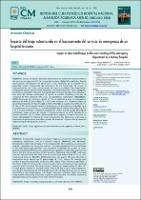| dc.contributor.author | Taype Huamaní, Waldo | |
| dc.contributor.author | De La Cruz Rojas, Lucila Amelia | |
| dc.contributor.author | Amado Tineo, José | |
| dc.date.accessioned | 2023-05-17T21:37:16Z | |
| dc.date.available | 2023-05-17T21:37:16Z | |
| dc.date.issued | 2021-12-31 | |
| dc.identifier.citation | Revista del Cuerpo Médico Hospital Nacional Almanzor Aguinaga Asenjo. 2021:14(4). | es_PE |
| dc.identifier.issn | 2227-4731 | |
| dc.identifier.uri | https://hdl.handle.net/20.500.12959/3685 | |
| dc.description.abstract | Objetivo: Evaluar el impacto del triaje estructurado en indicadores de hacinamiento del servicio de urgencias (SU) de un hospital terciario. Material y Métodos: Estudio observacional retrospectivo de diseño pre y post. Realizado en un hospital de la seguridad social, comparando las atenciones de dos trimestres. Se evaluó la implementación de triaje estructurado de cinco prioridades tipo Manchester, comparando número de atenciones, atendidos, prioridad de atención, tópico de ingreso, pacientes no atendidos, fallecidos en las primeras 6 horas y tiempo de primera atención. Con datos del sistema institucional se realizó el análisis estadístico (intervalo de confianza de 95%) utilizando SPSS 24.0, con aprobación institucional. Resultados: 42000 atenciones por trimestre, donde el 12% fue admitida a salas de observación. Mediana de edad 57 años (rango 14 - 103), sexo femenino 57%. Promedio diario de pacientes amanecidos en SU 240 vs 230 (p<0,01). Prioridad al ingreso: I 3%, II 44%, III 37%, IV 16% y V 0%. En el segundo trimestre disminuyeron las atenciones en prioridad I y se incrementaron en prioridad II y III. El promedio diario de pacientes no evaluados fue 20,5 y 13,7 en cada trimestre. Falleció en las primeras 6 horas el 0,13 y 0,15% del total de admisiones, según periodo de estudio. El tiempo promedio en el SU después de la primera atención fue 5,2 horas, disminuyendo en el segundo trimestre en todas las áreas. Conclusión: El sistema de triaje estructurado tipo Manchester disminuye la proporción de pacientes no atendidos, número de atendidos con prioridad I y tiempo en urgencia después de la primera atención. | es_PE |
| dc.description.abstract | Objetive: To assess the impact of structured triage on overcrowding indicators in the
emergency department (ED) of a tertiary hospital. Material and Methods:
Retrospective observational study of pre and post design. Carried out in a social security
hospital, comparing care during two quarters. The implementation of structured triage
of five Manchester-type priorities was evaluated, comparing the number of visits,
patients attended, priority of care, admission topic, patients not attended, patients who
died in the first 6 hours and time to first attention. Statistical analysis (95% confidence
interval) was performed with data from the institutional system using SPSS 24.0, with
institutional approval. Results: 42000 attendances per quarter, 12% were admitted to
observation wards. Median age 57 years (range 14 - 103), female 57%. Average daily
number of patients admitted to the ED was 240 vs 230 (p<0.01). Priority on admission: I
3%, II 44%, III 37%, IV 16% and V 0%. In the second trimester, priority I care decreased and
priority II and III increased. The daily average of patients not evaluated was 20.5 and 13.7
in each quarter. Deaths in the first 6 hours were 0.13 and 0.15% of total admissions,
according to the study period. The average time in the ED after first care was 5.2 hours,
decreasing in the second quarter in all areas. Conclusion: The Manchester structured
triage system reduces the proportion of patients not attended, the number of patients
attended with priority I and the time in the ED after first care | es_PE |
| dc.format | application/pdf | es_PE |
| dc.language.iso | spa | es_PE |
| dc.publisher | Seguro Social de Salud (EsSalud) | es_PE |
| dc.relation.uri | http://cmhnaaa.org.pe/ojs/index.php/rcmhnaaa/article/view/1455 | es_PE |
| dc.rights | info:eu-repo/semantics/openAccess | es_PE |
| dc.rights.uri | https://creativecommons.org/licenses/by-nc-sa/4.0/ | es_PE |
| dc.subject | Triaje | es_PE |
| dc.subject | Aglomeración | es_PE |
| dc.subject | Servicios médicos de urgencias | es_PE |
| dc.subject | Triage | es_PE |
| dc.subject | Crowding | es_PE |
| dc.subject | Emergency medical services | es_PE |
| dc.title | Impacto del triaje estructurado en el hacinamiento del servicio de emergencia de un hospital terciario | es_PE |
| dc.title.alternative | Impact of structured triage on the overcrowding of the emergency department of a tertiary hospital | es_PE |
| dc.type | info:eu-repo/semantics/article | es_PE |
| dc.subject.ocde | https://purl.org/pe-repo/ocde/ford#3.03.01 | es_PE |
| dc.subject.ocde | https://purl.org/pe-repo/ocde/ford#3.03.02 | es_PE |
| dc.identifier.doi | https://doi.org/10.35434/rcmhnaaa.2021.144.1455 | |






